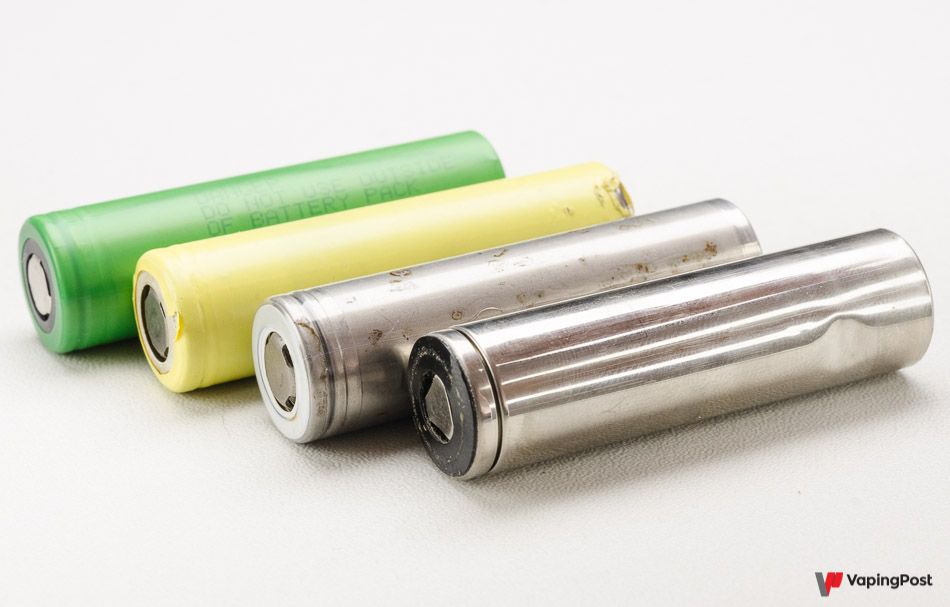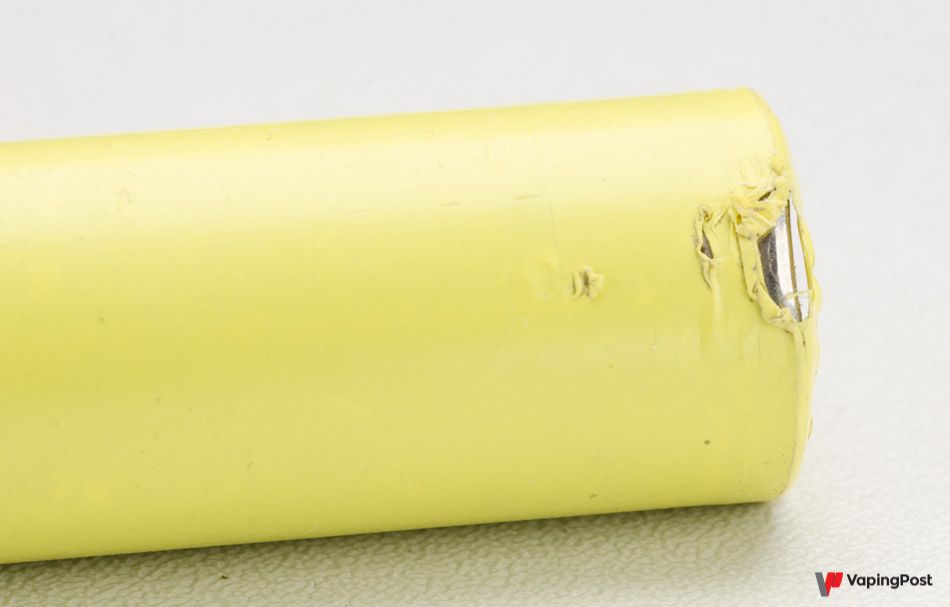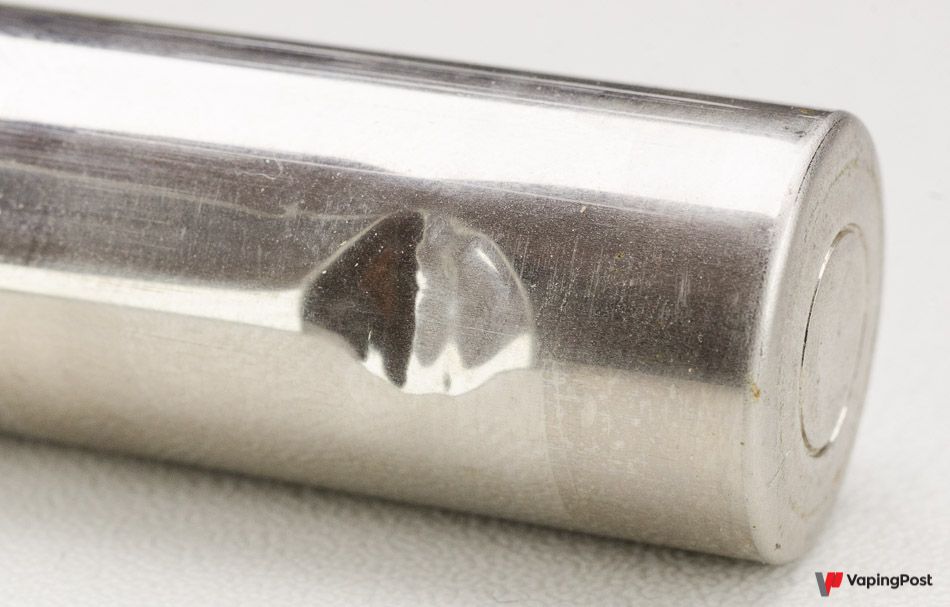When should you replace a battery?
Batteries are not everlasting, but it is not necessarily easy to determine when their replacement is necessary or essential. Below you will find some advice on how to decide when their performances are dropping, whether they have been breached or taken a knock.
End-of-life battery
 The 18650 and other batteries that we use generally last for between 300 and 500 full charge-discharge cycles. These numbers are just a rough guide, the service life of batteries is closely dependent on how they are used – this is also discussed in the articles on the key characteristics for battery charging. In practice, a battery is depleted when its performances drop and are no longer satisfactory. The most obvious sign is a gradual loss of capacity, resulting in a correspondingly reduced battery life.
The 18650 and other batteries that we use generally last for between 300 and 500 full charge-discharge cycles. These numbers are just a rough guide, the service life of batteries is closely dependent on how they are used – this is also discussed in the articles on the key characteristics for battery charging. In practice, a battery is depleted when its performances drop and are no longer satisfactory. The most obvious sign is a gradual loss of capacity, resulting in a correspondingly reduced battery life.
The internal resistance also increases once the battery is depleted, causing more heating. If your battery is heating more than usual in normal use, it is probably also reaching the end of its life. In this case, expecting any improvement is pointless, as both the tendency to overheat and for the battery life to decrease will only get worse – it is simply time to replace the battery.
Protective sleeve
 In simplified terms, the battery components are inserted in a metal tube topped with the positive contact. Therefore, the entire battery body acts as its negative pole, not only the bottom part! For this reason, it is very important for the protective plastic sleeve around the battery to remain in excellent condition. If a breach occurs, there is a genuine short-circuit risk.
In simplified terms, the battery components are inserted in a metal tube topped with the positive contact. Therefore, the entire battery body acts as its negative pole, not only the bottom part! For this reason, it is very important for the protective plastic sleeve around the battery to remain in excellent condition. If a breach occurs, there is a genuine short-circuit risk.
This is even more sensitive around the positive contact, where the insulator must be in perfect condition. The entire section around the positive is a negative contact, and if it is not completely insulated, you are liable to create a short-circuit merely by inserting the battery into your box!  Fortunately, if the protective sleeve is damaged, all is not lost, as replacement sleeves are readily available on the Internet. Simply gently remove the damaged sleeve, insert the unprotected battery into the small plastic tube, without forgetting the little ring around the positive, and heat. The sleeve is heat-shrinkable, and will take the desired shape in a matter of seconds. Obviously, you should take care not to overheat the battery itself; many tutorials are available to perform this operation properly very easily.
Fortunately, if the protective sleeve is damaged, all is not lost, as replacement sleeves are readily available on the Internet. Simply gently remove the damaged sleeve, insert the unprotected battery into the small plastic tube, without forgetting the little ring around the positive, and heat. The sleeve is heat-shrinkable, and will take the desired shape in a matter of seconds. Obviously, you should take care not to overheat the battery itself; many tutorials are available to perform this operation properly very easily.
Dark spots
 The battery may develop dark spots after some time, which are particularly visible if the sleeve is translucent. They are generally the result of moisture or e-liquid that has managed to infiltrate between the sleeve and the battery. You can then remove the sleeve, and there are two possible outcomes. Either the spots come off with a cloth, or at least the surface of the battery remains smooth; in this case, clean as well as you can and fit a new sleeve. The spots are only staining which has not reached the actual battery structure.
The battery may develop dark spots after some time, which are particularly visible if the sleeve is translucent. They are generally the result of moisture or e-liquid that has managed to infiltrate between the sleeve and the battery. You can then remove the sleeve, and there are two possible outcomes. Either the spots come off with a cloth, or at least the surface of the battery remains smooth; in this case, clean as well as you can and fit a new sleeve. The spots are only staining which has not reached the actual battery structure.
Otherwise, the battery metal is corroded, its surface is rusted or at least it is no longer smooth. In this case, oxidation has corroded the metal and the battery is ready to be recycled; continuing to use it is very clearly out of the question.
Impacts
 You have dropped your battery, and it has received a blow on its surface or in a corner. I am often alarmed at the response found in Facebook groups or on forums that it all depends on the type of impact – a minor impact is alright, but in the case of a bigger impact, you should stop using the battery. The only correct response is that a battery must be sent for recycling at the slightest impact on its surface, end of discussion! It is a matter of safety!
You have dropped your battery, and it has received a blow on its surface or in a corner. I am often alarmed at the response found in Facebook groups or on forums that it all depends on the type of impact – a minor impact is alright, but in the case of a bigger impact, you should stop using the battery. The only correct response is that a battery must be sent for recycling at the slightest impact on its surface, end of discussion! It is a matter of safety!
Inside, a battery is rolled up like sushi. The anode and the cathode are deposited in thin layers, and the whole is rolled up with the insulator and the electrolyte extremely compactly to form a cylinder. If an impact occurs, two components that are supposed to be separate will necessarily be pushed closer together at best, and be in contact at worst, regardless of the impact. In other words, there is no way of knowing how safe the battery is. It may work as normal, or explode as it discharges. As far as a battery concerned, there are no small or big impacts: if an impact occurs, the battery must be sent for recycling, there is no other option as there is no way of quantifying the risk that it now represents. And I repeat, the extent of the battery impact or warping doesn’t make any difference.
Don’t throw your batteries away!
As regards throwing a battery away, the answer is simple: never do it! Batteries are pollutants and potentially hazardous. They must be recycled via a special processing circuit. Many stores and supermarkets have used battery collection points, bring them with you when you go shopping and put them in the box.
To find out more…
Batteries are a huge topic; we have written a series of articles examining the question.
- As straightforward as it might be, battery charging requires some pointers and was well worth devoting an article to help you do so safely and effectively.
- Buying the right battery is good, but keeping it longer is even better! For this reason, we have compiled a comprehensive tutorial on extending the service life of your batteries.
- For those who want to find out more, our article on key battery characteristics explains everything you need to know about the battery capacity and maximum discharge current, and how they are determined.
- And if you want to understand how to optimise your battery choice and use, our article on battery specifications goes into more detail on the concepts of internal resistance, voltage sag, rated voltage, and provides details on the different chemistries.
- Finally, if you are one of the many people who believe the serial / parallel battery configuration or set-up resistance to have some importance in terms of battery life or the current drawn from batteries in an electronic box, our article on choosing batteries in an electronic box is for you.
- On another note, an article on e-cigarette battery explosions. As the media feast on these stories, despite them being extremely rare, we thought it was important to review this explosive topic to understand it, and above all prevent it from happening to you.
Don’t forget!
- Never use a battery beyond its specifications, both for battery life and your safety.
- Always carry batteries in suitable protection; most of the rare accidents that occur are linked with transporting unprotected batteries.
- Only use batteries that are in perfect condition, free from scratches or impacts.
- Never throw a battery away, place it in a specific recycling container.








